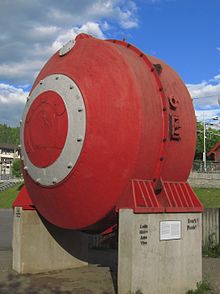伯克蘭-艾德法

伯克蘭-艾德法(挪威語:Birkeland-Eyde-prosessen,英語:Birkeland–Eyde process)曾是化學工業中一種硝酸的製備方法,主要用於氮肥生產。它是一種由多個步驟組成的固氮過程:高壓電弧使大氣中的氮氣(N2)與氧氣(O2)在3000 °C高溫中結合產生氮氧化物(NOx);二氧化氮(NO2)在水中溶解得到硝酸(HNO3);硝酸最終作為氮肥的生產原料,是硝酸鹽的來源。[1]
本方法由挪威科學家克里斯蒂安·伯克蘭研發[2],並與工業家山姆·艾德於1903年合作投產[2][3],建立在1780年代亨利·卡文迪什發現的化學現象的基礎之上。[4][5]在哈伯法與奧斯特瓦爾德法發明後,本方法因能效低、耗電大,在1910-1920年代間逐漸淘汰。[6]
反應
[編輯]
反應裝置核心是一個火花隙,因此有時也稱電弧爐。它的兩個電極由銅管制成,具有同軸式結構,採用水冷散熱。兩電極間施加電壓5 kV、頻率50 Hz的高壓交流電,使火花隙反覆快速放電[7],產生電弧。在電極周圍,還使用與電極方向垂直的電磁鐵施加一個靜磁場,它產生的洛倫茲力會將電弧拉伸為碟形薄片。
碟片形電弧是溫度大於3000 °C的等離子體。當空氣吹過電弧時,在高溫下,氮氣氧化產生一氧化氮。在自然界中,大氣中的閃電也能產生相同的化學反應,是可溶性硝酸鹽的一個來源。[8]此外,原則上也可以使用火焰、電熱鉑導線、普通電弧作為熱源——但效果不佳,不適合工業上大規模生產。伯克蘭-艾德的碟片形電弧不但能與空氣充分接觸,還大幅提升了反應器的功率上限。用這種方法產生的碟片形電弧直徑可達2米,發出太陽般的耀眼光芒。[6][7]

此反應速率在低溫時非常緩慢,因此必須在高溫下進行,降低溫度會使產量下降。[9][10]20世紀初實驗表明,溫度大於2000 °C時,反應速率「極快」,但在1000 °C時卻會「緩慢到難以測量」。[1]通過精心控制電弧的能量與氣流的流速,在3000 °C時可產生4%-5%的一氧化氮。本反應能耗極高,生產一噸硝酸需要消耗15兆瓦時(15,000千瓦時)的電能,1kWh電能僅能生產60g硝酸。伯克蘭的化工廠供電需要依靠附近的水力發電廠。[9][10]
高溫一氧化氮隨後冷卻,與大氣中的氧產生二氧化氮。此反應所需時間取決於空氣中NO的濃度,濃度為1%時需要180秒,濃度為6%時需要40秒,產率為90%.[11]
接着,用水溶解二氧化氮產生硝酸。最後用分餾法進行提純。[12]
吸收過程的設計對整個系統的效率至關重要。二氧化氮要通過一系列四層樓高的填料塔或板式塔,產生40-50%的硝酸(高於此濃度時,吸收速率驟降)。第一座吸收塔讓氣泡狀的二氧化氮穿過水與不發生反應的石英碎片。當達到最終濃度後,硝酸會轉移到一個花崗岩製成的容器中,塔中液體被第二座吸收塔中更稀的酸液替代。這個移動過程如此反覆,氣體與液體向相反的方向轉移,最後一座吸收塔需要不斷補充淡水。此時約20%的氮氧化物仍未反應,因此最末尾的吸收裝置中含有鹼性的石灰溶液,將剩餘的氮氧化物轉化為硝酸鈣(又稱挪威硝石),但仍有約2%的氮氧化物釋放到空氣中。[13]
硝酸是生產氮肥所需的硝酸鹽離子NO3−的來源,化學式為:
歷史
[編輯]1781年,英國化學家亨利·卡文迪什在過量空氣中燃燒氫,發現產生的水中含有硝酸。1785年,卡文迪什用電火花隙進一步研究發現,如果能量與氧氣供應充足,空氣中的氮氣可全部氧化為硝酸,但仍有約1/120的少量氣體不反應。1894年,瑞利勳爵重複了卡文迪什的實驗,最終與威廉·拉姆齊爵士合作發現了稀有氣體氬,同時也研究了能量輸入與硝酸產出的關係。[1]
為提高產量與效率,後人從大量實驗中得到了一系列結論:本化學反應的本質是氮氣的氧化,是需要在高溫下進行的未催化吸熱反應;溫度應大於2000度,而且一氧化氮必須能快速冷卻;原則上可以使用任何一種熱源,包括火焰、鉑電熱絲、電弧。之所以使用電弧,是因為火焰的高溫區大小有限,使空氣難以充分穿過,也不能迅速開關使氣體有效冷卻,而鉑電熱絲無法在金屬熔點之上工作;研究還發現使用高頻交流電、高阻抗、低電流時效果最佳。低電流意味着難以提升反應器功率與產能。[1]
1902年,美國人查爾斯·S·布拉德利(Charles S. Bradley)與迪米特·R·洛夫喬伊(Dimmitt R. Lovejoy)發明了一種具有多組小電極的圓形旋轉火花隙反應器,他們申請了專利,成立大氣產品公司(Atmospheric Products Co.),在紐約州尼亞加拉瀑布附近建立了一家小型化工廠。兩人希望用廉價的水電資源支持生產,然而公司在商業上並不成功,僅兩年後就停止運作[1][14],主要原因是產能低。在挪威,剛創刊不久的《電化學工業》發表了兩人的研究成果。伯克蘭看到這篇文章後,認為自己的單一碟形大電弧方案要優於多個小電弧。[7]
碟形電弧裝置最初由德國物理學家尤利烏斯·普呂克在1861年發明。在該實驗中,普呂克在火花隙周圍放置U型電磁鐵,使電磁鐵與電極兩端方向互相垂直,得到了碟片形電弧。隨後瓦爾特·能斯脫等人也重複了類似的實驗。[15][16]伯克蘭將其工業化,從而克服了電流限制,解決了反應器的功率問題,使大規模生產實用化。[1]使用電弧的靈感,來自他之前在實驗中發生短路的線圈炮發明。[17]

挪威的兩個城鎮留坎、諾托登曾建有使用此工藝的化工廠,並依靠附近的水力發電廠供電。1908年,諾托登工廠的固氮產量達7000噸;留坎的化工廠則是後來建成,年產量28000噸。[14]相比後來的新方法,伯克蘭-艾德法能效低、耗電大。在哈伯法與奧斯特瓦爾德法發明後,本方法在1910-1920年代間被挪威工業逐漸淘汰。今日,這兩個城鎮的工廠成為留坎-諾托登工業遺址,被聯合國教科文組織收錄於《世界遺產名錄》。[18]
在現代化工中,哈伯法使氫氣(H2)與大氣中的氮氣(N2)發生反應,轉化為氨(NH3)。其中的氫氣通常來自甲烷(CH4),使用蒸汽重整製備。奧斯特瓦爾德法隨後將氨轉化為硝酸(HNO3)。[6]
參見
[編輯]參考資料
[編輯]- ^ 1.0 1.1 1.2 1.3 1.4 1.5 Remsen, I.; Renoup, H. The Oxidation of Atmospheric Nitrogen with Reference to the Manufacture of Nitrates and Nitric Acid (PDF). American Chemical Journal. 1906, 35: 358–367 [2024-03-04].
- ^ 2.0 2.1 Lucy Jago. The Northern Lights. Knopf Doubleday Publishing Group. 2007.
Birkeland was deeply unhappy about having to share credit with Eyde, who had no part in the technical development of the idea, but he was forced to collaborate because only Eyde had access to the huge amounts of electric power that would be needed to run the furnaces.
- ^ Eyde, Sam. The Manufacture of Nitrates from the Atmosphere by the Electric Arc—Birkeland-Eyde Process. Journal of the Royal Society of Arts. 1909, 57 (2949): 568–576. JSTOR 41338647.
- ^ Cavendish, Henry. Experiments on air. Philosophical Transactions of the Royal Society of London. 1785, 75: 372–384.
- ^ Aaron John Ihde. The development of modern chemistry. Courier Dover Publications. 1984: 678. ISBN 0-486-64235-6.
- ^ 6.0 6.1 6.2 Trevor Illtyd Williams; Thomas Kingston Derry. A short history of twentieth-century technology c. 1900-c. 1950. Oxford University Press. 1982: 134–135. ISBN 0-19-858159-9.
- ^ 7.0 7.1 7.2 Lucy Jago. The Northern Lights. Knopf Doubleday Publishing Group. 2007.
More recently, two Americans, Bradley and Lovejoy, had built a small factory beside Niagara Falls to produce saltpeter at the end of 1902, but their attempt had proved too inefficient to form the basis of a new industry. A description of their furnace had been included in the first edition of a Norwegian scientific publication, Electrochem Indus-tri, launched only the previous month; Birkeland studied the drawings in the new magazine to check that his idea was different, and therefore potentially more rewarding, than theirs. He saw that they had made a myriad of tiny arcs in their furnace, while Birkeland was planning one large arc, repeated at a high rate and swept sideways by the magnetic field to make contact with as much air as possible. It would look like a circle with the shape and heat of the sun. The following Monday Eyde and Birkeland spent the morning together at the university, inspecting the strange-looking furnace and weighing each other up as potential business collaborators. The first prototype, cobbled together in a few hours, beautifully demonstrated Birkeland’s idea of using magnetism to make large electric arcs and the tremendous noise and smell it produced were persuasive testimony to its potential.
- ^ Karl Fisher; William E. Newton. G. J. Leigh , 編. Nitrogen fixation at the millennium. Elsevier. 2002: 2–3. ISBN 0-444-50965-8.
- ^ 9.0 9.1 Mellor, J. W. Modern Inorganic Chemistry. Longmans, Green and Co. 1918: 509.
- ^ 10.0 10.1 Martin, Geoffrey; Barbour, William. Industrial Nitrogen Compounds and Explosives. Crosby Lockwood and Son. 1915: 21.
- ^ Webb, H. W. Absorption of Nitrous Gases. Edward Arnold & Co. 1923: 20.
- ^ Douglas Erwin. Industrial Chemical Process Design. McGraw-Hill. 2002: 613. ISBN 0-07-137621-6.
- ^ Knox, Joseph. The Fixation of Atmospheric Nitrogen. D. Van Nostrand Company. 1914: 45-50.
- ^ 14.0 14.1 M. Kiefer, David. Capturing Nitrogen Out of the Air. Today's Chemist at Work (American Chemical Society). [2024-03-05]. ISSN 1532-4494. (原始內容存檔於2021-12-04).
- ^ Plücker. Ueber die Einwirkung des Magnets auf die elektrische Entladung [On the effect of the magnet on the electric discharge]. Annalen der Physik und Chemie. 1861, 113: 249–280 [2024-03-03]. (原始內容存檔於2024-03-03) (German). From p. 255: " … die Curven, welche dieselbe durchziehen, soweit die Schätzung des Auges reicht, genau die Form von Kreisbogen an[nehmen], die sämmtlich auf der die beiden Spitzen des Entladers verbindenden geraden Linie, als gemeinschaftlicher, senkrecht stehen." ( … the curves which [the luminous discharges] traverse, assume — as far as the eye can judge — exactly the form of circular arcs, all of which stand perpendicular to the same straight line that joins the two points of the electrodes.)
- ^ Worden, Edward Chauncey. Technology of Cellulose Esters 1:2. D. Van Nostrand Company. 1921: 870.
- ^ Lucy Jago. The Northern Lights. Knopf Doubleday Publishing Group. 2007.
When the ladies retired to the drawing room and the gentlemen stood around the fire, drinking whisky and smoking cigars, Birkeland approached Eyde and said, 「I have the solution.」 He explained that his cannon, of which Eyde was already aware through Knudsen, produced high-energy electric arcs if it short-circuited during testing—arcs exactly like bolts of lightning. Birkeland believed this faulty element of his gun design could be combined with electromagnetic furnace technology to ionize air and produce nitric acid.
- ^ Rjukan–Notodden Industrial Heritage Site. UNESCO. 2015-07-05 [2024-03-04]. (原始內容存檔於2020-07-03).




